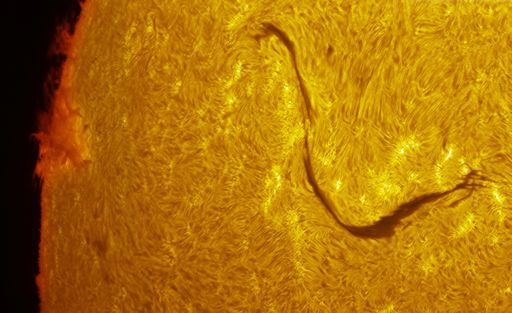 07-30-2014, 05:57 AM
07-30-2014, 05:57 AM
|
#1006
|
|
⊙▃⊙
  
Join Date: Nov 2007
Location: I live in the last place where you Look.
Age: 31
Posts: 7,376
|
 Re: Terry's Astronomy Thread.
Re: Terry's Astronomy Thread.
Daily Suspicious0bserver's Weather Post:
July 30, 2014
What's in the sky tonight?
July 30, 2014
-The two brightest stars of summer are Vega, just east of the zenith after dark, and Arcturus, less high toward the west. Both are zero magnitude. The next zero-magnitude star to make its appearance will be Capella. It doesn't emerge until the early-morning hours. Look for it low in the north-northeast after about 1 a.m. local time (depending on your location, especially your latitude).
-As the sunspot number rebounds from a deep low in mid-July, the chance of flares is increasing, too. However, the biggest threat for a flare today might not be a sunspot at all. Instead, our attention turns to a long dark filament of magnetism. Astrophotograher Jack Newton photographed the structure on July 29th from his observatory in Osoyoos, British Columbia. Stretching more than 100,000 km from end to end, and filled with dense plasma, the sinuous filament is held aloft by solar magnetic fields. If it snaps or collapses and hits the stellar surface below, the result could be a Hyder flare--a type of explosion that does not require a sunspot.
NOAA forecasters estimate an increasing 25% chance of M-flares and a small but non-negligible 5% chance of X-flares on July 30th.
 Astro Picture of the Day:
July 30, 2014
Source:
Astro Picture of the Day:
July 30, 2014
Source:
Andromeda is the nearest major galaxy to our own Milky Way Galaxy. Our Galaxy is thought to look much like Andromeda. Together these two galaxies dominate the Local Group of galaxies. The diffuse light from Andromeda is caused by the hundreds of billions of stars that compose it. The several distinct stars that surround Andromeda's image are actually stars in our Galaxy that are well in front of the background object. Andromeda is frequently referred to as M31 since it is the 31st object on Messier's list of diffuse sky objects. M31 is so distant it takes about two million years for light to reach us from there. Although visible without aid, the above image of M31 was taken with a standard camera through a small telescope. Much about M31 remains unknown, including how it acquired its unusual double-peaked center.
|

|

|